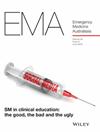Measurement of Serum Ammonia in the ED: Lost Opportunities
Abstract
Objective
Serum ammonia concentration is useful to identify adult onset inherited metabolic disorders in patients with encephalopathy, which are currently under-recognised. We investigated the current ammonia requesting practises in an Australian Tertiary Hospital Emergency Department (ED) to determine if hyperammonemia is being considered in adults presenting with non-hepatic encephalopathy.
Methods
A retrospective chart review was performed on all adult patients with a serum ammonia requested from a single tertiary ED over a 12 month period. The indications for ammonia testing, site of collection (ward vs. emergency department) and aetiology of hyperammonemia were recorded. An elevated serum ammonia level was defined as > 60μmol/L.
Results
A total of 597 serum ammonia tests were drawn from 439 patients, of which 177 (29.6%) tests were from patients with known inherited metabolic disorders. Ammonia ordering was higher on the ward (77.5%) than in the ED (22.5%); however, the ED had a higher proportion of orders with a hepatic indication for testing (89.8% vs. 63.4%). There were 666 emergency department presentations for confusion/coma or encephalopathy. Of these patients, 52 (7.8%) had an ammonia measured, 25 (3.8%) from ED. Other indications for ammonia measurement included valproate toxicity, altered mental status, seizures, and atypical neurological symptoms. No new cases of suspected metabolic disease were identified.
Conclusion
Ammonia testing from the ED remains predominantly in the assessment of patients with hepatic disease, which is not a guideline-recommended indication. Serum ammonia concentration is underutilised in cases of encephalopathy of unclear aetiology, potentially leading to missed diagnoses of metabolic disease.


 求助内容:
求助内容: 应助结果提醒方式:
应助结果提醒方式:


